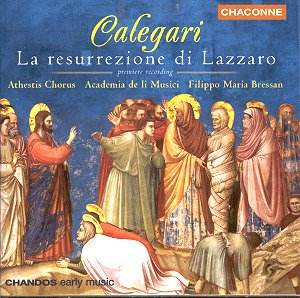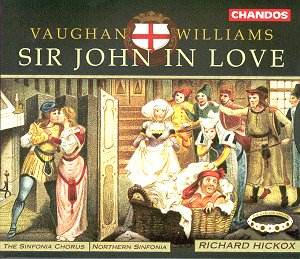 Composer: Antonio Calegari
Composer: Antonio Calegari
Works: La Resurrezione di Lazzaro
Performers: Academia de li Musici / Athesis Chorus / Filippo Maria Bressan; Roberta Giua, soprano; Luca Dordolo, tenor; Rosita Frisani, soprano; Manuela Custer, contralto; Salvo Vitale, bass
Recording: Rec Duomo di Monselice, June 2000
Label: Chandos Chaconne CHAN 0673 [78:11]
Antonio Calegari, a largely overlooked figure of the late 18th century, presents a fascinating study in contrast within his oratorio La Resurrezione di Lazzaro, composed at the tender age of twenty-two. This work, emerging from a rich tapestry of late Baroque and emerging Classical styles, invites listeners to reflect on the interplay of tradition and innovation prevalent in his time. Calegari, a contemporary of Mozart, straddles the classical and early romantic eras, and this piece encapsulates the stylistic nuances of both. Although he is primarily remembered for his operatic contributions, La Resurrezione di Lazzaro reveals his deft handling of sacred themes, offering a glimpse into the emotional and lyrical potential of sacred music on the cusp of transformation.
The performance by Academia de li Musici under the baton of Filippo Maria Bressan deserves particular commendation. Their approach to Calegari’s orchestration showcases a refined stylistic consistency, marked by a commendable adherence to historically informed performance practices. The ensemble’s use of reduced vibrato aligns seamlessly with the clarity required for this repertoire, allowing the intricate counterpoint and rich textures to emerge vividly. The opening Sinfonia, while conventional, sets a poignant atmosphere that is maintained throughout the work. The transition from the mournful “Morte, morte” chorus into the dramatic narrative is handled with deft precision, positioning the listener firmly within the emotional landscape Calegari crafted.
However, the interpretation of the vocal roles presents a more complex picture. The casting of a female soprano as Christ, while historically authentic—originally sung by a castrato—requires a mental adjustment for contemporary audiences. This choice, though perhaps jarring, mirrors modern theatrical interpretations of gender roles and can be seen as a refreshing, if unconventional, approach to this sacred drama. Yet, the singing of the soloists occasionally falters; particularly, the lower-lying passages for the sopranos struggle under the weight of modern vocal techniques, leading to moments that feel less than secure. The embedded vibrato employed by the vocalists contrasts with the clean execution of the instrumentalists, creating an inconsistency that detracts from the overall coherence of the performance.
Sound quality and engineering are commendable, capturing the vibrant acoustics of the Duomo di Monselice effectively. Chandos has ensured that the recording balances the instrumental clarity and vocal presence, allowing for a nuanced listening experience. The CD ROM included with the album enhances the offering, providing valuable historical context and a navigable libretto that enriches the listener’s engagement with the work.
Calegari’s La Resurrezione di Lazzaro, while a curiosity in the shadow of more prominent contemporaries, emerges as a significant contribution to the sacred music repertoire. The performance, despite its vocal shortcomings, reveals the potential for emotional depth and lyrical beauty within Calegari’s composition. This recording serves as an important reminder of the richness of the early Romantic landscape and the need to revisit and re-evaluate the works of those who have been overshadowed by their more famous peers. The commitment of Academia de li Musici and Athesis Chorus to present this work with care and authenticity positions this recording as a valuable addition to the discography of lesser-known sacred music.



